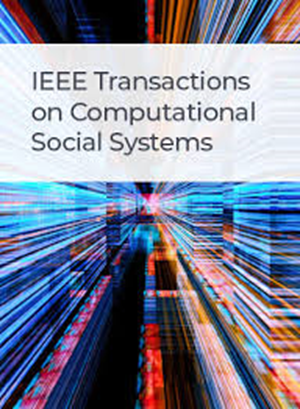Adapting GNNs for Document Understanding: A Flexible Framework With Multiview Global Graphs
IF 4.5
2区 计算机科学
Q1 COMPUTER SCIENCE, CYBERNETICS
IEEE Transactions on Computational Social Systems
Pub Date : 2024-10-21
DOI:10.1109/TCSS.2024.3468890
引用次数: 0
Abstract
Graph neural networks (GNNs) have recently gained attention for capturing complex relations, prompting researchers to explore their potential in document classification. Existing studies serving this purpose fall into two directions: inductive learning focusing on personalized context relations within documents and transductive learning targeting the global distribution relations among documents in a corpus. Both directions extract distinct types of beneficial structural information and yield encouraging outcomes. However, due to the incompatibility of underlying graph structures and learning settings, developing an enhanced model that effectively integrates local and global relational learning within existing frameworks is challenging. To address this issue, we propose a new GNN-based document representation learning framework that incorporates multiview global graphs at both the word and document levels, focusing on learning the diverse global distribution information of texts at different granularities. Additionally, a contextual encoder derives the initial representations of document nodes from the updated representations of word nodes, integrating personalized context relations into document representations during this process. Finally, we tailor a node representation learning strategy for the multiview global graphs, called the multiview graph sampling and updating module, which allows our framework to operate efficiently during training without being constrained by the scale of the global graph. Experiments indicate that our framework generally enhances performance by integrating both global and local relational learning. When combined with large-scale language models, our framework achieves state-of-the-art results for GNN-based models across multiple datasets.适应gnn用于文档理解:一个具有多视图全局图的灵活框架
近年来,图神经网络(gnn)因捕获复杂关系而受到关注,促使研究人员探索其在文档分类中的潜力。现有的研究分为两个方向:关注文档内部个性化上下文关系的归纳学习和关注语料库中文档之间全局分布关系的转导学习。两个方向都提取了不同类型的有益结构信息,并产生了令人鼓舞的结果。然而,由于底层图结构和学习设置的不兼容性,在现有框架中开发一个有效集成局部和全局关系学习的增强模型是具有挑战性的。为了解决这一问题,我们提出了一种新的基于gnn的文档表示学习框架,该框架在单词和文档级别结合了多视图全局图,专注于学习不同粒度的文本的各种全局分布信息。此外,上下文编码器从单词节点的更新表示派生文档节点的初始表示,并在此过程中将个性化上下文关系集成到文档表示中。最后,我们为多视图全局图定制了一个节点表示学习策略,称为多视图图采样和更新模块,该模块允许我们的框架在训练期间高效运行,而不受全局图规模的限制。实验表明,我们的框架通过整合全局和局部关系学习总体上提高了性能。当与大规模语言模型相结合时,我们的框架可以实现跨多个数据集的基于gnn的模型的最先进结果。
本文章由计算机程序翻译,如有差异,请以英文原文为准。
求助全文
约1分钟内获得全文
求助全文
来源期刊

IEEE Transactions on Computational Social Systems
Social Sciences-Social Sciences (miscellaneous)
CiteScore
10.00
自引率
20.00%
发文量
316
期刊介绍:
IEEE Transactions on Computational Social Systems focuses on such topics as modeling, simulation, analysis and understanding of social systems from the quantitative and/or computational perspective. "Systems" include man-man, man-machine and machine-machine organizations and adversarial situations as well as social media structures and their dynamics. More specifically, the proposed transactions publishes articles on modeling the dynamics of social systems, methodologies for incorporating and representing socio-cultural and behavioral aspects in computational modeling, analysis of social system behavior and structure, and paradigms for social systems modeling and simulation. The journal also features articles on social network dynamics, social intelligence and cognition, social systems design and architectures, socio-cultural modeling and representation, and computational behavior modeling, and their applications.
 求助内容:
求助内容: 应助结果提醒方式:
应助结果提醒方式:


